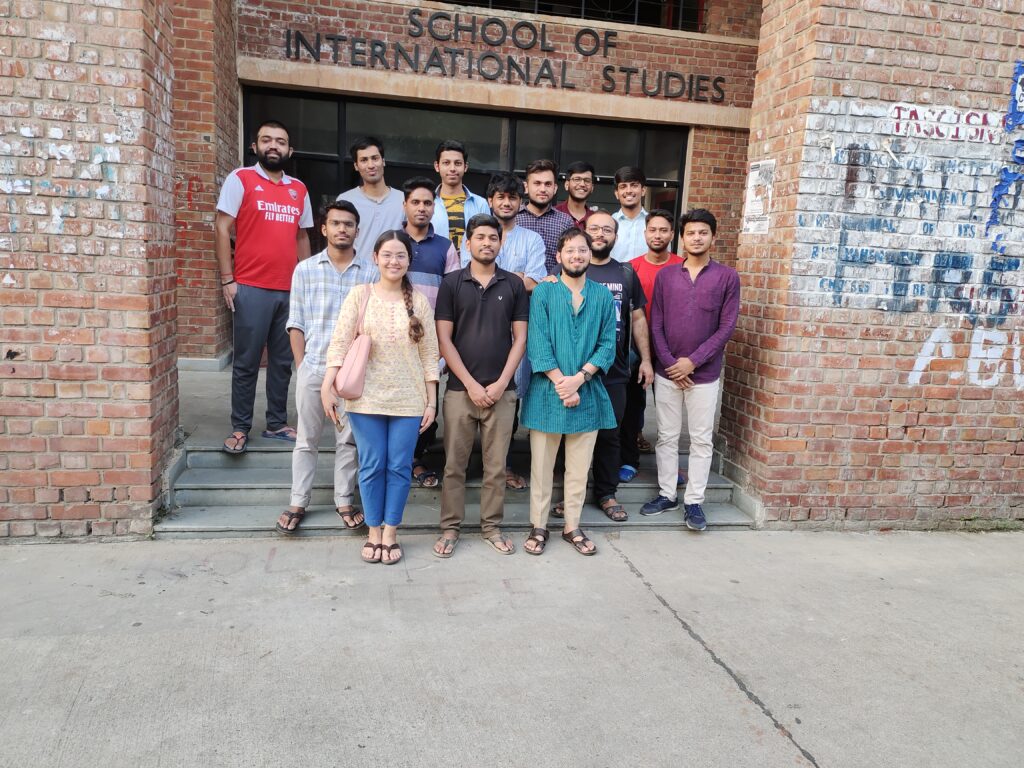
This blog provides discussion highlights for Sunday IR Cafe #52. Conducted on 21st May 2023, the discussion covered The Myth of Multipolarity: American Power’s Staying Power.
Core Arguments:
- There exists a widespread consensus among IR scholars and policymakers on international politics moving away from the United States’ unipolar domination. While some believe in the onset of a new bipolarity between the US and China, others see multipolarity in the offing. Stephen Brooks and William Wohlforth, two formidable scholars of American power, challenge these widely-held assumptions.
- For Wohlforth and Brooks, the US and China are miles apart from other states when it comes to military power and economic heft. The power gap between these two and others belies any claim of a multipolar world. Between China and the US, however, there also exists a relative power gap that makes the system partially unipolar. In terms of economic measures, China’s GDP data might be overestimated, and it lags far behind the US in economic dynamism and innovation prowess, as reflected in metrics like the top national firms’ profit share and intellectual property royalties. In the military domain, the balance of power in terms of weapons crucial to the command of the commons remains heavily skewed in favor of the US. The exorbitant privilege of the dollar, the unrivaled alliance system, and the web of international institutions add to the US power advantage.
- Given the benefits the US draws from fostering and maintaining the liberal international order, it should eschew retrenchment in favor of cooperation with the allies to punish revisionism and ensure stability. At the same time, the US should also ask the allies to pick up more burden for self-defense and provide them access to the US market.
Discussion:
- The import of the article lies in convincingly contesting the claims of the multipolar nature of international politics. However, beyond just assessing the relative power distribution, we should also consider investigating the underlying motives of states in proclaiming the onset of multipolarity. The Soviet Union probably won’t have been as invested in the idea of multipolarity as Russia has been. For a relatively weaker Russia, the proclamation of a multipolar world allows it to justify its desire for a sphere of influence in its backyard. For China which desires a bipolar world, the rhetoric of multipolarity possibly serves as a reassuring mechanism towards other Asian middle powers apprehensive of China’s rise. For India, the talks of multipolarity stem from an instinctive hostility towards the US’ unipolar domination, an inevitable sense of its rise as a great power, and the desire to dominate the South Asian region.
- In assessing the military power balance to determine polarity, mere quantitative bean-counting of advanced weapon systems won’t suffice. Raw indicators of military balance on paper might not translate into usable military capability on the battlefield. The qualitative aspect of military balance, thus, warrants more attention. To be sure, Wohlforth and Brooks adhere to this approach in comparing the American and Chinese submarines, with the former being more stealthy and hence more effective. Similarly, we need to consider the asymmetric impact of weapons systems on military balance. For instance, what does China’s use of relatively inexpensive anti-ship ballistic missiles against the US aircraft carriers tell us about the military balance?
- One way to parse the multipolarity vs. bipolarity debate is to look at regional power distribution. The East Asian region, then, can increasingly be seen to be bipolar in terms of both military and economic sinews of power. As Stephen Biddle and Ivan Oelrich argue, the development of A2/AD capability will entail a Chinese sphere of influence over the mainland, a US sphere of influence around the allied landmass, but also a contested battlespace around much of the South and East China Sea. This seems to be a fair characterization of bipolarity at a regional level. Further, when it comes to global power projection, the US clearly has the advantages, in no less measure due to decades of headstart. But, China has also started courting friendly states around the globe to gain access to port facilities which can add to Beijing’s global power projection capability. Having said that, the US still retains the command of the commons to a significant extent since China’s A2/AD measures are unlikely to be effective much away from its shores, primarily owing to the difficulty of radar functionality in the hostile and contested battle zones away from a friendly landmass.
- Brooks and Wohlforth seem to underestimate China’s economic prowess by focusing on a few selective intellectual property-related indicators. Going beyond just the GDP numbers, one could also point to the technologies of the future with dual-use capabilities or strategic implications in which China is either in the leading position or contesting the US very closely. These domains would include Artificial Intelligence, Quantum Computing, green technology transition, and drones, to name a few. The Western academia’s earlier confident pronouncements on China’s supposed innovation deficit due to institutional arrangements (the rule of law, private property, freedom of speech, etc.) have so far turned out to be a case of stale prophecies gone wrong. Hence, while China does face innovation challenges, as evident in semiconductor chips production and design, it should not be written off lightly.
- While we should avoid portraying China as 10 feet tall, it is difficult to accept the claim that the CCP regime won’t be able to extract resources from society as efficiently as the USSR did. Surely China does not have the centralized planning apparatus anymore; still, the sheer size differential between the Soviet and Chinese economies means the CCP can afford to spend a lot on military apparatus, even if it diverts resources from society at a rate lower than that of the USSR. Further, the unmistakeably strong grip of Xi and the CCP over Chinese society despite a bungled COVID response should tell us something about the regime’s ability to mobilize resources without endangering political stability and regime survival; hyping up nationalism a la Wolf Warrior diplomacy can buttress the regime’s resource mobilization potential. Given the Chinese prowess in manufacturing and the tendency of developing nations to hedge their bets, it won’t be difficult for the CCP to ensure the supply of raw materials and ramp up defense production, should the need arrives. In contrast, manufacturing outsourcing and cuts in defense production have atrophied the US defense industrial base when it comes to ramping up production for great power competition.
- In their prescriptions for the US grand strategy, Wohlforth and Brooks have seemingly shifted their positions subtly in the liberal hegemony debate. Contra their earlier paper (with G John Ikenberry), in which they refuted the notion of American allies as free riders and made a case for an actively engaged US military force posture, their Foreign Affairs article asks allies to pick up more burden for self-defense. Wohlforth and Brooks also caution against using the military to alter the status quo and starting any unnecessary war. Seemingly in recognition of the shift in the international system towards partial unipolarity, they have unwittingly moved closer to the retrenchment advocates whom they have been battling for the past decade or so.
- On the issue of America’s economic engagement with allies, an unlikely coalition has emerged in the domestic debate that favors the continuation of the liberal economic order based on free trade deals and market access for allies. Hegemonic realists (Wohlforth and Brooks, and probably Carla Norrlof), progressives (most notably Van Jackson), and of course, liberal internationalists have come together against the Trump-Biden turn towards protectionism, which has been driven by the plight of the domestic white working class, the imperatives of green transition, and the recognition of the need to contain China. While the hegemonic realist and liberal internationalist partnership have a long pedigree, it is interesting to see the progressives emerge as the defender of free trade and better deals for allies. Driven by the unit-level logic of the peace dividend of economic interdependence, Jackson and even Adam Tooze want the US to continue doing more of the same. The progressive position becomes anomalous, however, in light of their steadfast opposition to neoliberal globalization. It would be interesting to see the progressive thinkers reconcile their welfarist and peace-centric readings of neoliberal globalization. Opposed to excessive US militarism and its pointillist empire, the progressives would also be at odds with the hegemonic realists who stress the necessity of the panoply of military bases and a forward force posture that undergirds the liberal economic order.
- India’s impressive rise and desire for a multipolar world in which it is a pole bring us to the issue of ordering vision. As Rahul Sagar has shown, nineteenth and twentieth-century Indian strategic thinking has been very hostile to the idea of playing the role of traditional great power. However, as India grows in power and stature and faces a challenging external security environment, the trappings of a traditional great power behavior become difficult to avoid. In such a situation, Indian strategic elites might need to devise new sort of role conceptions and narratives to sell India’s ordering vision and justify its behavior.
(Discussion Transcript and Editing by Sanjeet Kashyap)

